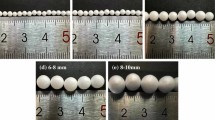Abstract
The application scope of expanded polystyrene (EPS) concrete is continuously expanding because of its excellent thermal insulation ability and light weight. Research on EPS concrete has mainly focused on its strength and thermal insulation performance. In order to perform finite element analysis of the EPS concrete structure, it is necessary to investigate not only the relationship between the strength, density, and admixture but also the uniaxial compressive stress–strain curve and Poisson's ratio. Herein, the stress–strain curves and other mechanical parameters were obtained by a uniaxial compression test of EPS concrete prismoid specimens with densities of 1000–1600 kg/m3. Based on the experimentally observed data, the effects of dry density, fly ash content, and sand content on the strength, elastic modulus, and stress–strain curve of EPS concrete were methodically investigated. The results show that the strength-density curve is in the form of a power function. Meanwhile, the strength decreased by approximately 15% and 13% with the addition of 10% fly ash and 10% sand, respectively. Furthermore, the elastic modulus increases with an increase in density such that the corresponding curve is approximately linear. Finally, the variation law of the uniaxial compressive stress–strain relationship curve associated with EPS concrete was analyzed. The results revealed that the mechanical behavior of EPS concrete is quite different from that of ordinary concrete. This study provides a convenient approach for the finite element analysis of prefabricated light steel-EPS concrete composite structures.













Similar content being viewed by others
References
Babu KG, Babu DS (2003) Behaviour of lightweight expanded polystyrene concrete containing silica fume. Cem Concr Res 33(5):755–762. https://doi.org/10.1016/S0008-8846(02)01055-4
Babu DS, Babu KG, Wee TH (2005) Properties of lightweight expanded polystyrene aggregate concretes containing fly ash. Cem Concr Res 35(6):1218–1223. https://doi.org/10.1016/j.cemconres.2004.11.015
Babu DS, Babu KG, Wee TH (2006) Effect of polystyrene aggregate size on strength and moisture migration characteristics of lightweight concrete. Cem Concr Compos 28(6):520–527. https://doi.org/10.1016/j.cemconcomp.2006.02.018
Bouvard D, Chaix JM, Dendievel R, Fazekas A, Letang JM, Peix G, Quenard D (2007) Characterization and simulation of microstructure and properties of EPS lightweight concrete. Cem Concr Res 37(12):1666–1673. https://doi.org/10.1016/j.cemconres.2007.08.028
Cook DJ (1973) Expanded polystyrene beads as lightweight aggregate for concrete. Precast Concr 4(4):691–693
Cui CC, Huag Q, Li DB, Quan CR, Li HC (2016) Stress-strain relationship in axial compression for EPS concrete. Constr Build Mater 105(2016):377–383. https://doi.org/10.1016/j.conbuildmat.2015.12.159
He DY, Zheng WK, Chen ZL, Qi YL, Zhang DW, Li H (2022) Influence of paste strength on the strength of expanded polystyrene (EPS) concrete with different densities. Polymers 14(13):2529. https://doi.org/10.3390/polym14132529
Lanzón M, García-Ruiz PA (2009) Lightweight pozzolanic materials used in mortars: evaluation of their influence on density, mechanical strength and water absorption. Cem Concr Compos 31(2):114–119. https://doi.org/10.1016/j.cemconcomp.2008.11.003
Liu DZ, Liu H, Zhang FP (2021) Behaviour of the joint between slabs and walls composed of light steel and foam concrete. Adv Struct Eng 24(11):2427–2440. https://doi.org/10.1177/13694332211003290
Liu HD, Cao RD, Zhang E, Tian MY, Lu GY (2017) Experimental study of the properties of EPS concrete and manufactured sand-EPS concrete. In: Joint conferences of international conference on materials science and engineering application.
Miled K, Roy RL, Sab K, Boulay C (2003) Compressive behavior of an idealized EPS lightweight concrete: size effects and failure mode. Mech Mater 36(11):1031–1046. https://doi.org/10.1016/j.mechmat.2003.08.004
Ministry of Housing and Urban-Rural Development of China (2015) Code for design of concrete structures (GB50010 2010). Beijing, China
Ministry of Housing and Urban-Rural Development of China (2019) Technical standard for application of lightweight aggregate concrete (JGJ/T 12-2019). Beijing, China
Ozel M (2011) Thermal performance and optimum insulation thickness of building walls with different structure materials. Appl Therm Eng 31(17):3854–3863. https://doi.org/10.1016/j.applthermaleng.2011.07.033
Rao YX, Liang CF, Xia Y (2012) Experimental research on physical and mechanical properties of EPS recycled concrete. In: International conference on civil, architectural and hydraulic engineering
Sadrmomtazi A, Sobhani J, Mirgozar MA, Najimi M (2012) Properties of multi-strength grade EPS concrete containing silica fume and rice husk ash. Constr Build Mater 35(2012):211–219. https://doi.org/10.1016/j.conbuildmat.2012.02.049
Sargin M (1971) Stress-strain relationships for concrete and the analysis of structural concrete sections. University of Waterloo.
Sayadi AA, Tapia JV, Neitzert TR, Clifton GC (2016) Effects of expanded polystyrene (EPS) particles on fire resistance, thermal conductivity and compressive strength of foamed concrete. Constr Build Mater 112(2016):716–724. https://doi.org/10.1016/j.conbuildmat.2016.02.218
Sun Y, Li CX, You JJ, Bu CM, Yu LW, Yan ZT, Liu XP, Zhang Y, Chen XR (2022) An investigation of the properties of expanded polystyrene concrete with fibers based on an orthogonal experimental design. Mater 15(2022):1228. https://doi.org/10.3390/ma15031228
Vinod BR, Surendra HJ, Shobha R (2022) Lightweight concrete blocks produced using expanded polystyrene and foaming agent. Mater Today Proc 52(2022):1666–1670. https://doi.org/10.1016/j.matpr.2021.10.503
Yuan J, Wang LB, Li WL, Yang HL, Wang JJ, Zhang WH, Xiong ZZ (2022) A new EPS beads strengthening technology and its inflfluences on axial compressive properties of concrete. Sci Eng Compos Mater 29(2022):50–64. https://doi.org/10.1515/secm-2022-0005
Acknowledgements
This work was supported by the National Natural Science Foundation of China: Study on Failure Mechanism of Light Steel and Foamed Concrete Composite Structures (Grant No. 51378238), and the Science and Technology Development Program of Jilin Province: Research and Development and Application of New Prefabricated Light Steel and Lightweight Concrete Composite Structure System (Grant No. 20190303030SF). The authors would also like to express their gratitude to EditSprings (https://www.editsprings.com/) for providing expert linguistic services.
Author information
Authors and Affiliations
Corresponding author
Ethics declarations
Conflict of interest
No potential conflict of interest was reported by the authors.
Rights and permissions
Springer Nature or its licensor (e.g. a society or other partner) holds exclusive rights to this article under a publishing agreement with the author(s) or other rightsholder(s); author self-archiving of the accepted manuscript version of this article is solely governed by the terms of such publishing agreement and applicable law.
About this article
Cite this article
Liu, H., Liu, D., Yu, Q. et al. Experimental Scrutiny of Uniaxial Compressive Stress–Strain Relationship for Expanded Polystyrene Concrete. Iran J Sci Technol Trans Civ Eng 47, 2931–2948 (2023). https://doi.org/10.1007/s40996-023-01112-y
Received:
Accepted:
Published:
Issue Date:
DOI: https://doi.org/10.1007/s40996-023-01112-y




